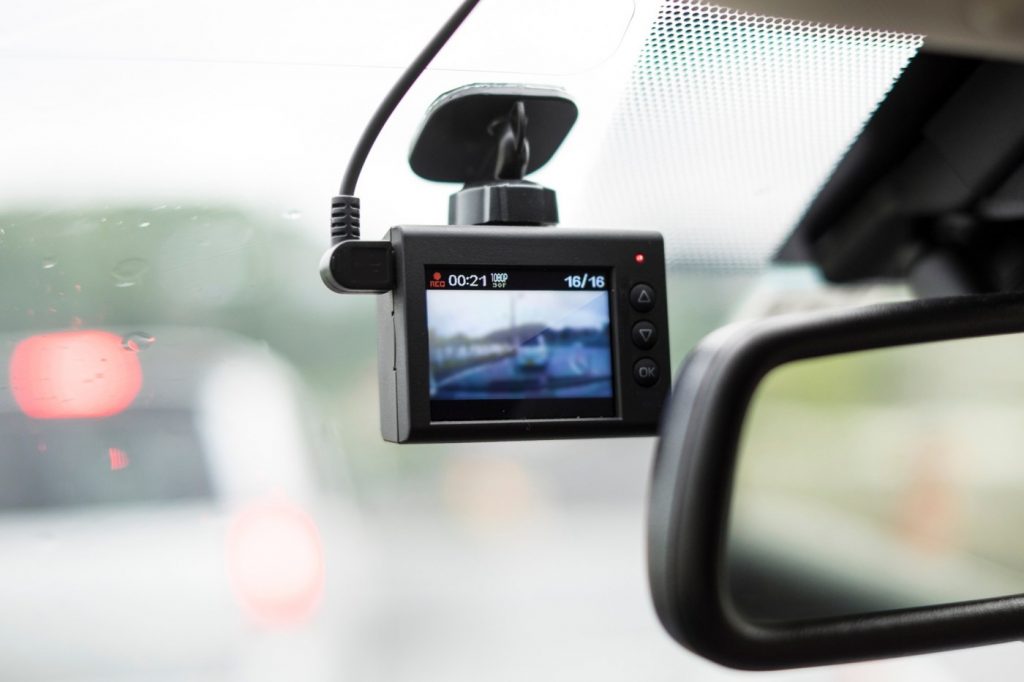A red Toyota Tacoma swerves into oncoming traffic, a shocked bystander curses, and others scream as the out-of-control pickup careens into a crowded downtown Fullerton.
The dramatic footage, captured on a camera in a passing vehicle and displayed in a courtroom earlier this year, was one of the first things shown to jurors tasked with deciding whether the pickup’s driver — Christopher Solis — was criminally liable for the 2019 crash that injured nine people. He was convicted earlier this year of hit-and-run causing injuries, hit-and-run causing property damage, and being in possession of a drug.
Whether providing key evidence for criminal trials or piece of mind for motorists worried they will get wrongly blamed for collisions, dash cameras — small, in-vehicle recording systems — are an increasingly common part of automobile culture.
Investigators say that dashcam video has joined surveillance cameras, attached to homes and businesses, as a new tool for law enforcement.
“Every camera provides an angle,” Orange County sheriff’s Sgt. Frank Gonzalez said. “It is not a tell-all, but the more angles we have, the more tools we have, the better we are able to paint the best picture.”
The recollections of those involved in traumatic events, including traffic collisions, are often unclear or incomplete.
“In any traumatic event, it is hard to remember every single memory,” Gonzalez said.
That at-times subjective views of witnesses and participants often make video evidence, including footage captured on dashcams, a key part of traffic investigations.
“It is a fantastic tool for us,” said California Highway Patrol Officer Cameron Averill, who works felony investigations. “They hold people accountable, whether it is right-doing or wrongdoing.”
The officer recalled one incident when a vehicle swerved across a couple of freeway lanes and struck a motorcycle, killing the rider.
The car’s driver claimed he was driving at normal freeway speed and wasn’t reckless. But dashcam footage provided by another driver who stopped and waited for law enforcement shows the driver had actually been speeding, Averill recalled.
“The people who actually have dashcam evidence are more willing to give it up if they know they are innocent,” the officer said.
For some major cases, law enforcement officials have asked the public for any dashcam evidence or other video, particularly when other investigative avenues have been exhausted.
Within days after the 2021 road-rage shooting in Orange County that killed 6-year-old Aiden Leos, on his way to kindergarten with his mom, the CHP put out a call to the public for help.
“If you were traveling north on 55 Friday morning between the hours of 7:55 and 8:15 in the morning and your vehicle does have a dashcam, we’re urging that you please call our CHP office, provide us with that video, maybe we can find something,” a CHP spokesman said at the time, according to CBS News.
The footage that ended up helping identify gunman Marcus Anthony Eriz came initially from grainy cellphone video of the vehicle he was traveling in, later bolstered by surveillance footage from cameras along the freeway. But in their call for assistance, investigators initially sought dashcam footage. Earlier this year, Eriz was sentenced to 40 years to life in prison.
Torrance Sgt. Tyrone Gribben tussles with a man who assaulted him. The dash camera footage that captured the incident is part of the YouTube series “In the Passenger Seat,” created by the Police Department. (Photo courtesy of Torrance Police Department)
Related Articles
Pedestrian dies after being hit by driver in West San Jose
Palo Alto bicyclist dies of injuries suffered in solo crash
Driver strikes, kills bicyclist in Newark
Single mother killed by vehicle in Burlingame was selfless, caring, friend says
Bicyclist killed in collision with driver in Campbell
Dashcams with front-facing cameras generally cost $100 to $300, while models with an additional interior camera or other features can cost a couple hundred dollars more. Some new cars come equipped with them.
Law enforcement officers aren’t the only ones increasingly using dashcam footage for investigations.
Andre Beverly, a Redondo Beach resident and longtime private investigator who routinely works with insurance companies looking into collisions, said dashcam footage can help both fill in the recollections of those involved in traffic accidents while also helping to prove or disprove their stories.
“When you are involved in an accident, (you remember) bits and pieces, then you start to fill in the blanks in your mind,” Beverly said. “You have to be careful to see if someone is being consistent with the details they are providing. …
“There is no emotion behind it,” Beverly said of video. “It just shows what it shows.”
A driver involved in one collision described another driver pulling out of a driveway and into the street and causing a collision — a story Beverly was deeply skeptical of. But when the driver whose car had been struck provided dashcam footage, it backed up his story.
“Sure enough, it shows this completely ridiculous move (by the other driver),” Beverly said.
In another instance, a vehicle was struck by a big rig, whose driver claimed the other vehicle had pulled into his lane. The dashcam footage proved the big rig driver had actually caused the crash, Beverly said.
“The dashcam showed our driver was minding his own business in his lane and got clipped and spun,” Beverly said. “That was it, they started writing checks to us.”
Other drivers recalled dashcam footage helping then out with everyday collisions.
Mary Taddeo, a Huntington Beach resident, was driving a Lexus SUV to a nearby store off of Talbert Avenue near Brookhurst Street when a driver going the opposite direction abruptly turned left in front of her — causing her to slam on her brakes, swerve and hit a curb.
The other driver was congenial, Taddeo said, but insistent that he hadn’t done anything wrong. After she sent him footage from her dashcam, Taddeo said, the other driver agreed to pay for the damage to her vehicle.
“It was the video that he went, ‘Oh, OK, you are right, I did do that,’ ” Taddeo said. “It is just there in case I need it.”
Terry Benson, a Redondo Beach resident, had spent several years thinking about getting a dashcam for his Lexus SUV. He once saw another car try to escape slowing traffic on the 405 Freeway by moving into another lane — only to be struck from behind.
“I thought that would have been great if I had a dashcam for that,” Benson said. “I wouldn’t have to explain everything.”
He did end up being a witness — and the buyer of a dashcam.
John Robertson, a Long Beach resident, bought a dashcam as “self-defense.”
“Every single minute, pretty much, people do things on the roadway that are stupid, no matter where you go,” he figured.
Robertson said he believes that having a dashcam has made him a better driver as well.
“I don’t want to be at fault and have it be recorded, so it makes me more careful,” he said. “It makes me remind myself that I need to drive as sensibly as I expect others to.”


